Bounce rate has always been a terrible metric.
And now it’s even worse.
But first, what is bounce rate?
Bounce rate is the percentage of people that “bounce” off your website before doing anything meaningful. They load the page and then leave your website.
In theory, the metric was supposed to give insights into what parts of your website pull in users and which parts repel them. In practice, it does neither.
The New Definition of Bounce Rate in Google Analytics 4
In the new version of Google Analytics (Google Analytics 4), a user bounces if they:
- Spend less than 10 seconds on the site
- Don’t visit any other pages
- Don’t trigger a conversion event
If that feels like an insanely low bar for a user that doesn’t bounce, that’s because it is. Unsurprising to anyone that’s been doing online marketing for awhile, it’s common for 50% of users to not even hit this bar. People’s attention on the internet is fleeting. Shocker.
Making this more complicated, bounce rate is now tied to a new metric in Google Analytics 4 called engagement rate.
Engagement rate is the inverse of bounce rate, it’s the percentage of users that do one of these things in their session:
- Spend over 10 seconds on the site
- Visit a second page
- Trigger a conversion event
In other words, bounce rate and engagement always add up to 100%, they’re the inverse of each other.
That also means there’s no reason to ever look at both metrics. If you are going to use one of them, only use one. They both tell you the exact same thing.
The Old Definition of Bounce Rate in Universal Analytics
For well over a decade, bounce rate had a very different definition: a visitor was considered a “bounce” if they didn’t trigger a second action during their Google Analytics session. That could be a second pageview or an event call, it just had to happen in the same session.
This is how it worked in the old version of Google Analytics (Universal Analytics) along with earlier versions. In fact, bounce rate had this definition when I first got started well over a decade ago.
Let’s say a new visitor loaded a blog post, spent 5 minutes reading it, and then closed the browser tab. That would have been considered a bounce since they didn’t trigger a second Google Analytics tracking call.
During this period, most industry professionals considered bounce rate a worthless metric. People are way too busy to just explore sites for fun, this isn’t 1997. People have a question, they want an answer, and then they want to get back to their day. Only a small percentage of folks are going to take any action on your site.
I just grabbed this Universal Analytics report from one of our sites:
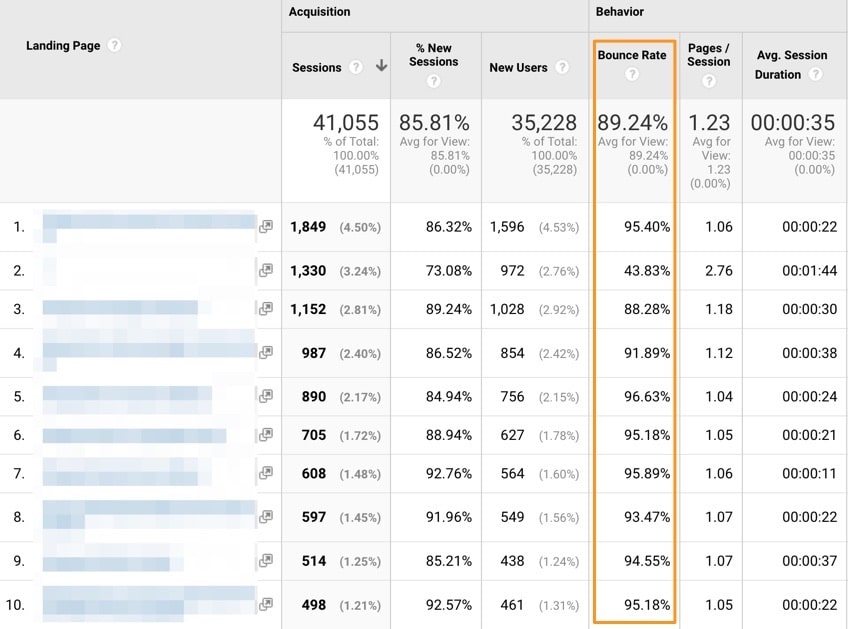
It’s a blog and almost all the pages have bounce rates of 90% or above. The main page that doesn’t is the homepage. That makes sense, many folks use homepages to navigate so more of them are triggering a second pageview, keeping the bounce rate lower.
But can I learn anything from this? Take action on anything? I don’t think so.
Bounce rate in Universal Analytics was a worthless metric and just noise. In all my years of online marketing and running sites with hundreds of thousands or millions of visitors per month, I can’t think of a single example of when a bounce rate told me something useful. And I never heard of one either. Professionals just ignore it. I haven’t even looked at bounce rate since I got my Google Analytics certification back in 2011.
This was an open secret. I told countless people over the years to just ignore the metric. I assume Google heard this advice too and attempted to improve it with Google Analytics 4. Hence all the changes.
Did Google Analytics 4 Make Bounce Rate Useful?
Nope. Not at all.
While Universal Analytics had bounce rates that were artificially high, Google Analytics 4 has a bounce rate that looks better than it is.
First, bounce rates on a standard small site are laughably worthless. Here’s some real data from a small site that we’re working on:
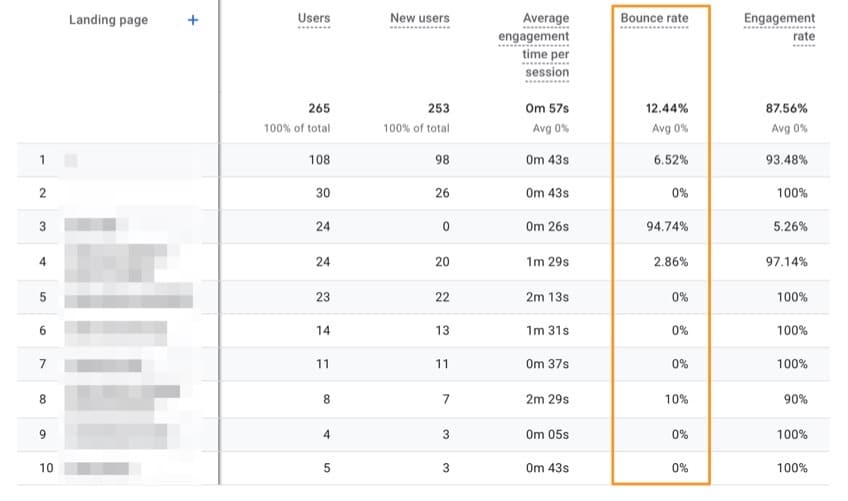
Bounce rates are zero or close to it for any page getting traffic. The only pages with higher bounce rates might actually be a tracking bug.
What about larger sites? After all, small sites can have weird traffic behavior. Small inconsistencies appear more impactful than they are until they get washed out in larger traffic flows. Let’s look at a site that does over 100,000 sessions/month:
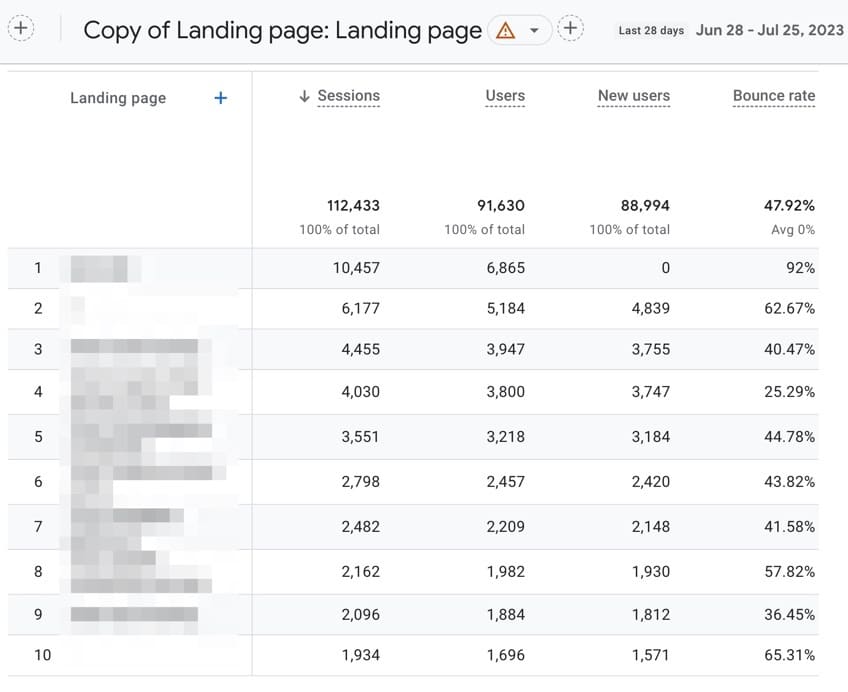
Now bounce rates feel real. I checked multiple sites that do at least 100,000 visits or above and didn’t see any major patterns between content types. Most pages tend to have a bounce rate of 30-60% with the new definition in Google Analytics 4.
Compared to the old bounce rate, this is so much worse.
But why?
If I look at this report, it feels like the bounce rate should be telling me something important. There’s a huge difference between a 30% bounce rate and a 60% bounce rate. Doesn’t that mean one page is helping people and the other isn’t?
I don’t think so at all.
The internet has been around for awhile, we’ve all got really freaking good at navigating web pages. We’re all pros by now.
That also means we can find what we want really quickly: click, scroll, scroll, here it is, close.
I play a fair number of video games and I’m always looking up random info. The best character build, best equipment, item locations, boss stats, that sort of thing. When I’m searching for answers, I regularly spend less than 10 seconds on a page, even when I get the answer that I need.
Remember that bounce rate doesn’t tell us what the user does after looking at our site. Do they go somewhere else because they were unsatisfied with our site? Or did they get their answer and move on with their day? We have no idea.
If you have a blog post with a 60% bounce rate, that could mean that you’re doing an amazing job helping people.
What if that post gives people the exact answer they need right at the top? They’ll load the page, get what they need, then bounce. And that’s a good thing. Google will see this and learn that your site gives instant answers. Then you’ll get more traffic as Google Ranks you higher.
Your bounce rate could be trash but your site could still be awesome.
That makes bounce rate a terrible metric to spend time on. I’d much rather spend time with metrics that give me clear answers.
What’s a Good Bounce Rate?
If every bounce rate is useless, it doesn’t matter what a “good” bounce rate is.
Again, I ignore bounce rates entirely. In Google Analytics 4, most pages will have bounce rates between 30-60%. If a bounce rate is higher than 60%, maybe there’s a technical problem that’s worth looking into.
Or maybe it’s a fluke.
Either way, I spend zero time comparing bounce rates or trying to get any useful insights from them.
How to Get Bounce Rate in Google Analytics 4
Bounce rate is not enabled by default in Google Analytics 4. If you want it to appear in a report, you’ll need to pull up the report and then customize it. In the report customization settings, click on Metrics:
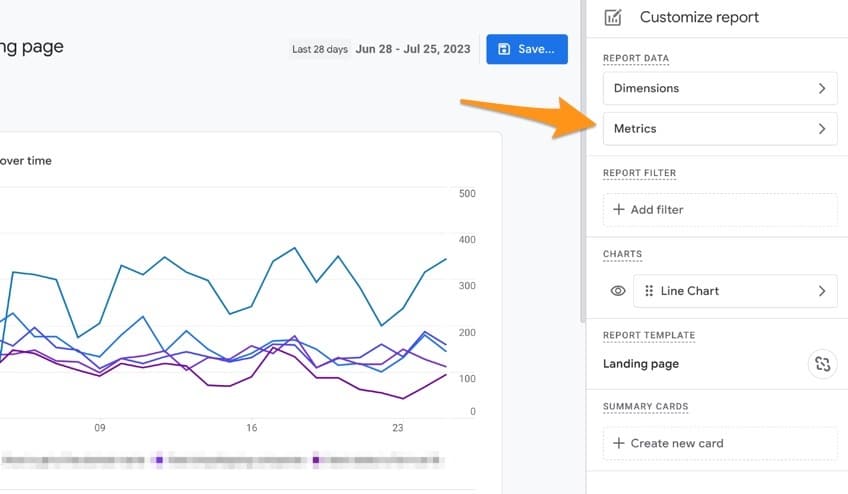
This gives you the list of metrics that will show up in the report. To add bounce rate, click on the empty Add metric box:
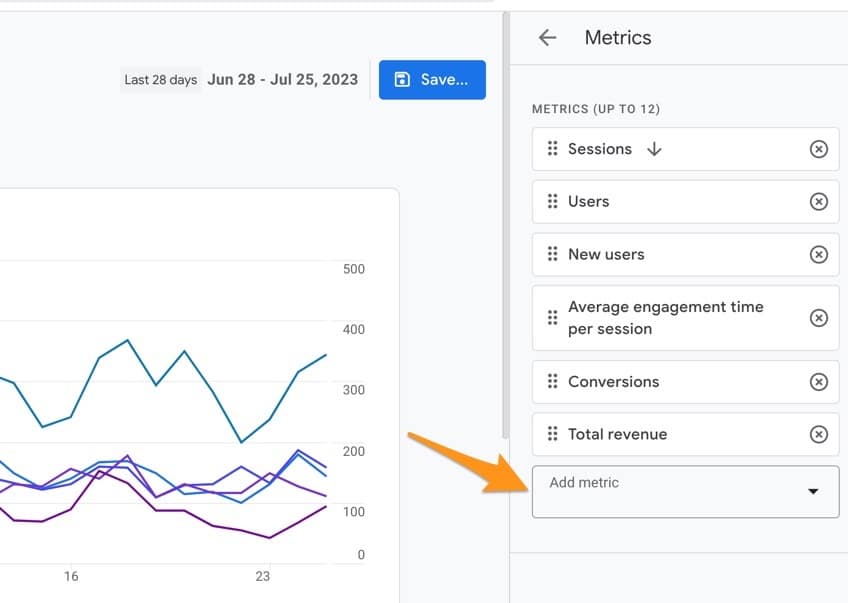
Search for Bounce Rate, pick it, then save the report. You can also adjust the order of metrics however you like.
Once you’re done, you’ll get a report like this:

Yes, bounce rate is a little buried in Google Analytics 4. I do understand why they did this. Bounce rate is beyond useless in my opinion. But if you really want it, now you know where to find it.
How to Improve Bounce Rate
First: don’t improve bounce rate. You should make your bounce rate WORSE.
I’m serious.
If you really want to have a better site, your bounce rate will get worse.
Let’s use an easy example. Most folks will tell you to improve your site speed. If your site is faster, users are happier and they’re more likely to spend time on your site. Right?
Wrong.
If you speed up your site, your bounce rate will get worse. People will find what they need and more of them will bounce off your site faster. They got what they wanted!
And this is a good thing!
If you told me that your site-wide bounce rate had improved, I’d actually start wondering if you made your site worse. There’s all sorts of ways to force people to spend more time on your site:
- Throw in a giant table of contents so people have to scroll a few extra times
- Add multiple popups with super small “x” buttons that people have to fight through
- Slow the site down, buying you a few extra seconds before all the content fully loads
- Stuff more mid-content ads, forcing even more scrolls
- Add a lengthy story about how you learned to make cinnamon rolls from your grandma (we all love those on recipe posts)
I could go on and on.
Every single one of these ideas would improve your bounce rate. But they will hurt your rankings and traffic long-term as they annoy your visitors.
If your boss is telling you to improve bounce rate, tell them they have no idea what they’re talking about. Then go focus on a metric that actually matters.
